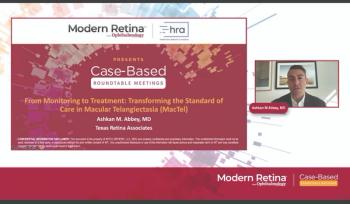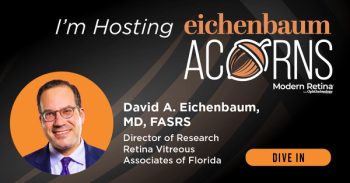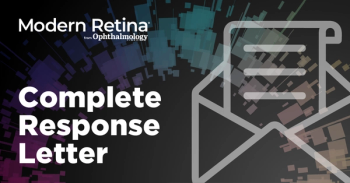
- Modern Retina July and August 2025
- Volume 5
- Issue 3
ASRS 2025: Geographic atrophy on display
A look at podium presentations on GA research at ASRS 2025.
The
ANX007
David A. Eichenbaum, MD, FASRS, spoke on the ARCHER II clinical trial (
Previously, Priya S. Vakharia, MD, a retina specialist at Retina Vitreous Associates of Florida in Tampa Bay and an associate of Eichenbaum, shared outcomes from the ARCHER phase 2 trial at Retina World Congress 2025, which was held in May in Fort Lauderdale, Florida.2 Together, these conference presentations show the continued effort to understand how to preserve the vision of patients with GA and the value of participating in clinical trial research and scientific meetings, such as ASRS, which Eichenbaum also highlighted in his editorial in this issue.
OCU410
Jay Chhablani, MD, presented on the safety and efficacy of OCU410. This candidate is a novel modifier gene therapy for the treatment of patients with GA. Previous reporting notes that OCU410 showed positive preliminary efficacy and safety data from the phase 1 dose-escalation portion of the phase 1/2 OCU410 ArMaDa clinical trial (
AVD-104
AVD-104 is an optimized intravitreal glycomimetic nanoparticle. This therapeutic candidate aims to increase the efficacy and safety of GA treatment with its differentiated dual method of action, working further upstream by powerfully inhibiting macrophage and complement cascade amplification. The SIGLEC trial (
VOY-101
Omer Trivizki, MD, MBA, is presenting “First Time Results of VOY-101, a Novel, Complement-Modulating Gene Therapy for Geographic Atrophy.” VOY-101 is an adeno-associated virus (AAV)–based gene therapy that aims to supplement specific sequences of FHL1 following a single intravitreal injection. A phase 1/2 dose-escalation study is expected to be completed in November 2025.5 This first look at the results from this clinical trial may help to show the value of a gene therapy for treating GA.
References
1. Annexon provides update on ARCHER II global registrational program in geographic atrophy. News release. Annexon Inc. August 5, 2024. Accessed July 22, 2025. https://ir.annexonbio.com/news-releases/news-release-details/annexon-provides-update-archer-ii-global-registrational-program
2. Vakharia PS, Crago SM, Filkins K. Q&A: Priya S. Vakharia, MD, shares insight into the phase 2 ARCHER trial for GA. Ophthalmology Times. May 30, 2025. Accessed July 22, 2025. https://www.ophthalmologytimes.com/view/q-a-priya-s-vakharia-md-shares-insight-into-the-archer-trial
3. Ocugen announces compelling preliminary data for OCU410—a single dose novel modifier gene therapy to treat geographic atrophy secondary to dry age-related macular degeneration. News release. Ocugen. November 19, 2024. Accessed July 22, 2025 https://www.globenewswire.com/news-release/2024/11/19/2983456/0/en/Ocugen-Announces-Compelling-Preliminary-Data-for-OCU410-a-Single-Dose-Novel-Modifier-Gene-Therapy-to-Treat-Geographic-Atrophy-Secondary-to-Dry-Age-Related-Macular-Degeneration.html
4. Geographic atrophy. Aviceda Therapeutics. 2025. Accessed July 22, 2025. https://www.avicedarx.com/program/geographic-atrophy.html
5. Rathi S, Hasan R, Ueffing M, Clark SJ. Therapeutic targeting of the complement system in ocular disease. Drug Discov Today. 2023;28(11):103757. doi:10.1016/j.drudis.2023.103757
Articles in this issue
5 months ago
Can AI explain AMD to patients?Newsletter
Keep your retina practice on the forefront—subscribe for expert analysis and emerging trends in retinal disease management.












































